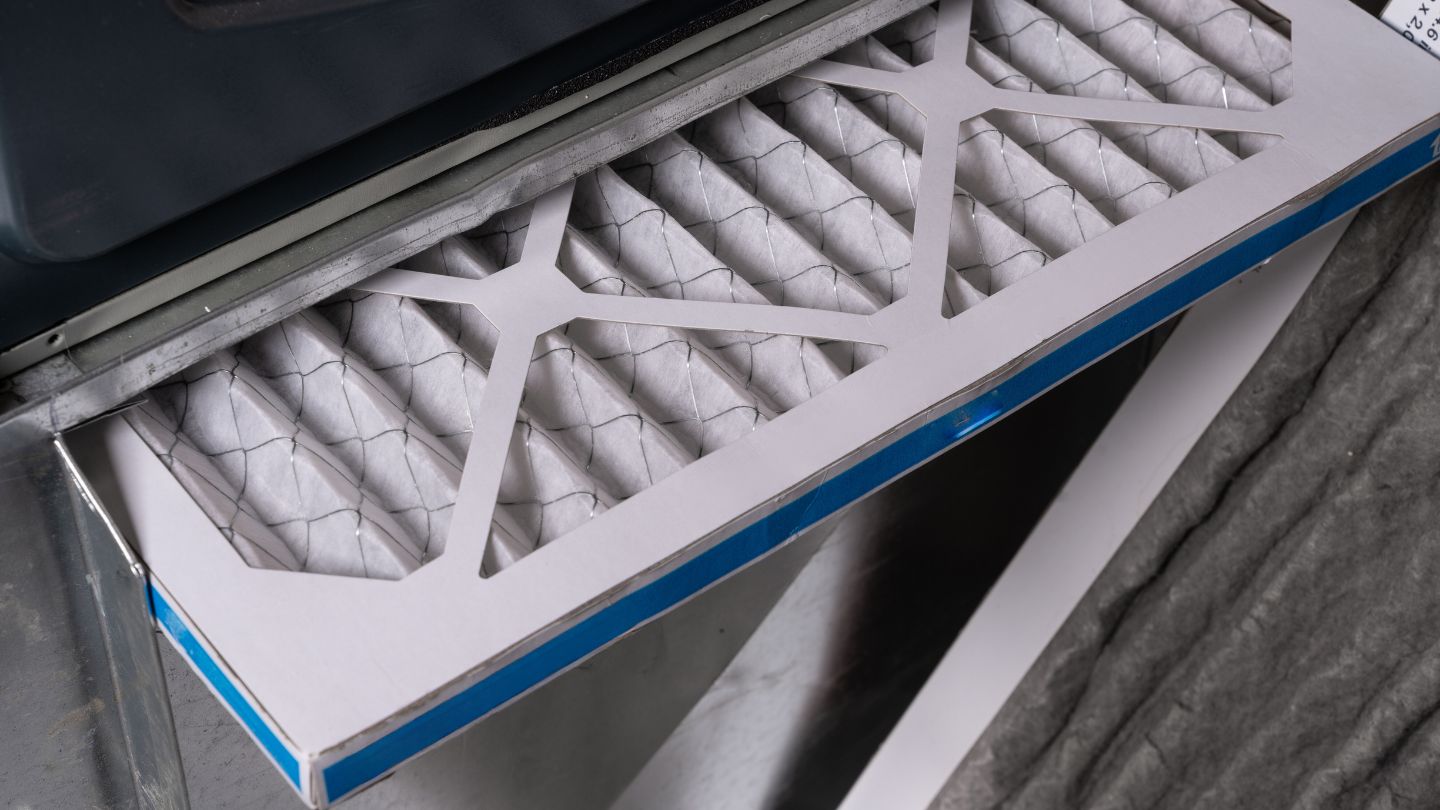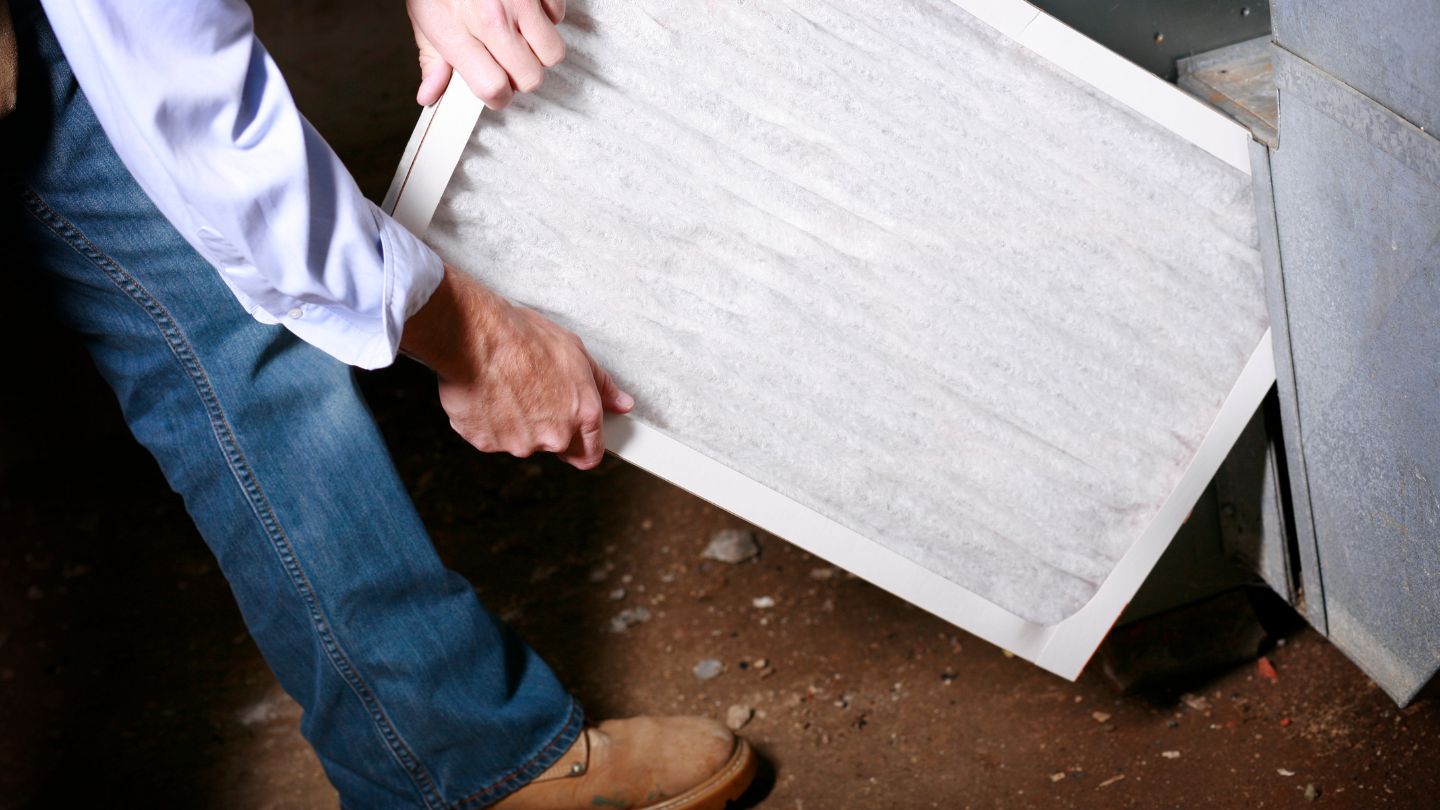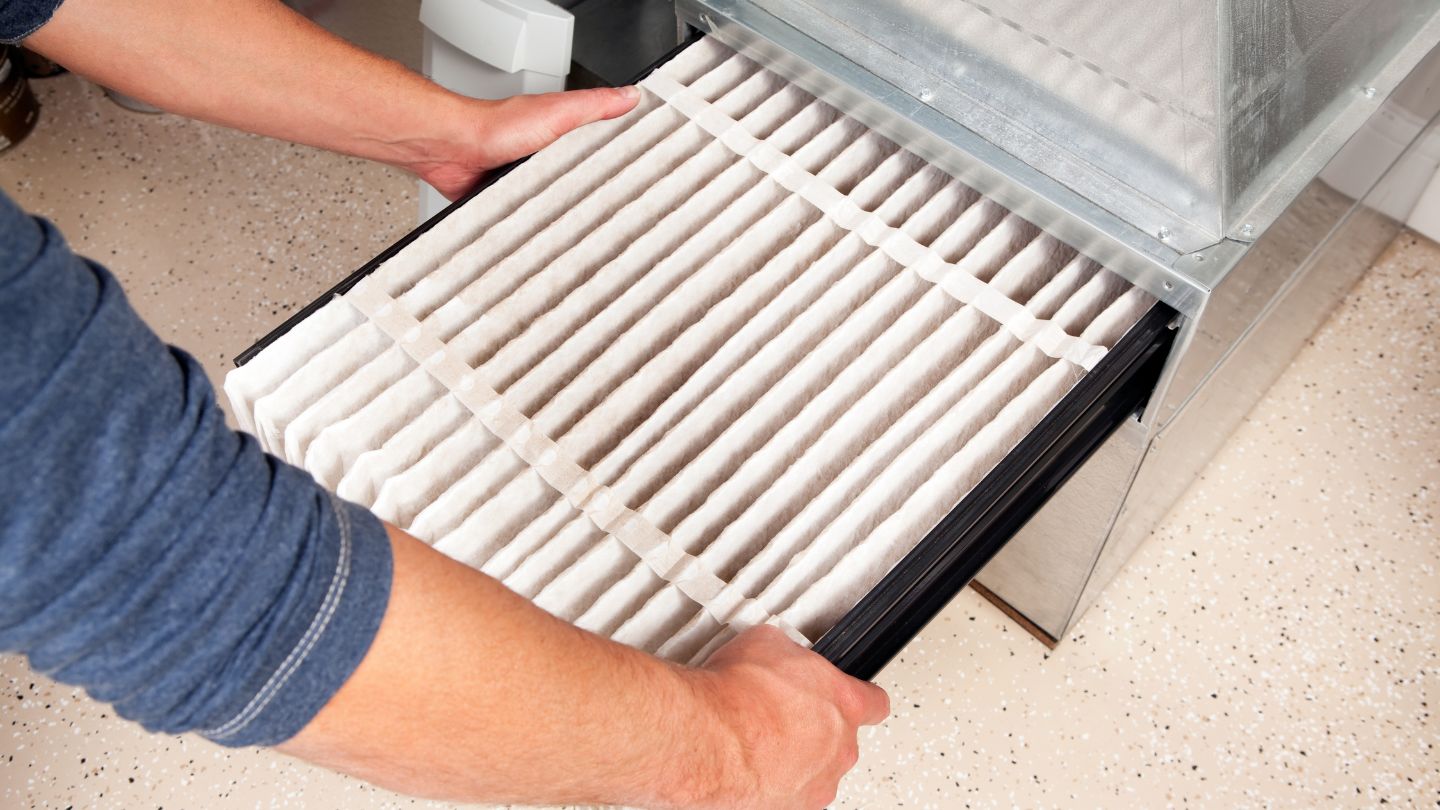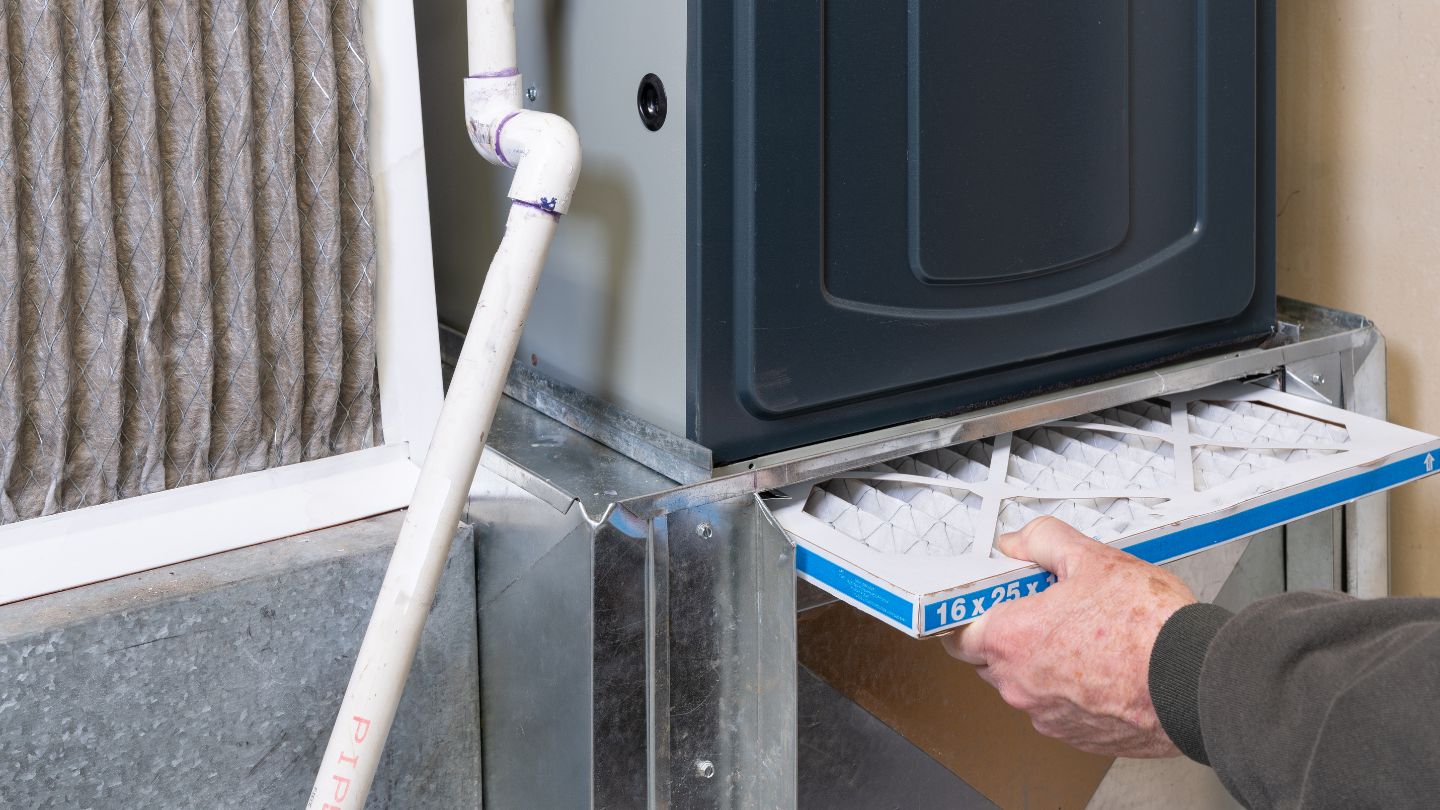Knowing the furnace air filter location is essential for maintaining air quality and the efficiency of your HVAC system. Regularly replacing your furnace filter not only improves your home’s air quality but also helps your heating and cooling system operate more effectively. This guide will help you locate and replace your furnace filter, making HVAC maintenance easier and keeping your system running smoothly.
Key Takeaways
- Furnace filter locations vary depending on home design and furnace type; filters are commonly found in basements, garages, utility closets, or attics.
- Regular replacement of furnace filters is crucial for air quality and HVAC efficiency. Frequency depends on factors such as household size, indoor air quality, and pets.
- Selecting the right furnace filter, considering the MERV rating and size, is essential for optimal HVAC performance.
Understanding Your Furnace
Understanding your furnace is crucial to maintaining its efficiency and performance. A furnace is a heating system that runs on propane, natural gas, electricity, or heating oil. The type of energy or fuel used depends on the type of furnace installed in your home. If your home has central air, the furnace usually shares the air handler with the air conditioner. The furnace filter is an essential component of the heating system, and its location varies depending on the type of furnace you have. Knowing where your furnace filter is located and how it functions can help you keep your HVAC system running smoothly and your indoor air quality high.
Locating Your Furnace Filter
Finding your furnace filter is the first step to effective HVAC maintenance. Knowing the type of heating or cooling system installed in your home is crucial, as it can influence the filter’s placement and accessibility. The filter’s location depends on the type of furnace as well as your home’s layout. Here’s where you’ll likely find it:
Common Furnace Filter Locations
- Basement or Utility Closet: In many homes, furnaces are located in basements or utility closets, often near other large appliances like water heaters or washing machines. The filter is typically found within the furnace compartment, behind a door or panel.
- Attic or Crawl Space: In some homes, particularly in warmer climates, furnaces are placed in attics or crawl spaces to save indoor space. Though this makes access more challenging, regular maintenance of these filters is essential to keep your HVAC system functioning efficiently.
- Garage: Homes without basements or attics often house their furnaces in the garage. Here, the filter is commonly found behind a front cover or door on the furnace itself, making it more accessible for maintenance.
- Horizontal HVAC Unit: In horizontal HVAC units, the furnace filter is positioned horizontally within the unit. It is crucial to keep this filter clean to ensure proper air flow and efficiency.
Identifying the Furnace Filter Location by Unit Type

The type of furnace you have can also influence where the filter is located. Here are the most common furnace types and where their filters are typically found:
- Up-Flow Furnace: In an up-flow furnace, the filter is located within the blower compartment, usually near the cold air return. These units pull cool air from below, heat it, and release warm air from the top, so the filter placement is designed to catch airborne particles before air circulation begins.
- Down Flow Furnace: Downflow units have filters situated in the upper blower compartment. They use a V-shaped filter design that often requires two filters to maintain airflow effectively. Air is pulled in from the top and directed downward, making regular filter changes essential for smooth operation.
- Horizontal Furnace: Typically found in attics or crawl spaces, horizontal units have filters on the intake side in a sliding rack. This design allows for easy access and quick filter changes, even in confined spaces.
- Air Handler Units: In homes with central air conditioning, air handler units house filters in an integrated filter rack behind a door. These units may also have additional filters within the central return duct, though using multiple filters can reduce system efficiency. It’s usually recommended to keep only one filter in place to ensure adequate airflow.
- Vertical HVAC Unit: In a vertical HVAC unit, the filter is typically located in the blower compartment, similar to up-flow and down-flow configurations. These units can be configured for either up-flow or down-flow air movement, making it crucial to maintain the filter to ensure optimal performance and air quality.
Replacing the Furnace Filter
Replacing the furnace filter is a simple and essential task to maintain the efficiency and performance of your heating system. Before replacing the filter, turn off the power to the heating system at the circuit breaker or fuse box. Locate the filter and remove any screws, clips, or latches holding it in place. Gently pull out the old filter and discard it. Inspect the filter housing for any debris or dust. Install a new filter, making sure it’s properly seated and secure. Replace any screws, clips, or latches to secure the new filter. Turn the power back on at the circuit breaker or fuse box. Regularly replacing your furnace filter ensures that your HVAC system operates efficiently and maintains good indoor air quality.
How Often Should You Replace Your Furnace Filter?

The frequency of furnace filter replacements depends on several factors, including the size of your household, pets, and the overall indoor air quality. Regular replacements ensure clean air, efficient HVAC operation, and lower energy costs. Here are the main factors that affect replacement frequency:
- Household Size: Larger households produce more dust, dander, and other airborne particles, requiring more frequent filter replacements.
- Pets: Pets add hair and dander to the indoor environment, which can clog filters quickly. Homes with pets typically need to replace filters every 30–60 days.
- Indoor Air Quality: Homes with higher levels of airborne contaminants or without air purification systems may require more frequent filter changes. Pollutants like smoke, pollen, and chemical vapors can accumulate in filters and reduce system efficiency if not replaced regularly.
Types of Furnace Filters
Furnace filters vary widely in design and efficiency. Choosing the right type depends on your air quality needs, budget, and HVAC compatibility. Here’s a look at the main types of furnace filters:
1. Panel Air Filters
Panel air filters are basic, affordable options, often made from pleated paper or fiberglass. They’re typically 1–6 inches thick and are suitable for homes with average air quality needs. These filters provide adequate filtration but may need more frequent replacements in households with pets or sensitive individuals.
2. Electronic Air Filters
Electronic air filters remove dust and other particles from the air by applying an electrical charge, capturing contaminants more effectively than basic filters. These filters are washable, making them a durable choice for homes needing high filtration levels. Homes with significant air quality concerns, such as those with allergens or smokers, can benefit from electronic air filters.
3. Combination Filters
Combination filters use both mechanical and electronic filtration techniques, capturing a wide range of particles and offering excellent air quality. They’re a solid choice for households looking to maximize filtration without compromising on airflow.
Choosing the Right Furnace Filter

The effectiveness of a furnace filter is often measured by its Minimum Efficiency Reporting Value (MERV), which rates filters on their ability to trap particles of different sizes. When selecting a filter, consider both the MERV rating and the filter size to ensure it fits your furnace correctly.
Understanding MERV Ratings
The MERV rating system ranges from 1 to 20, with higher ratings indicating greater filtration ability. Most homes are adequately served by filters with a MERV rating of 8–13, which capture common allergens like dust and pollen. Choosing the right MERV rating balances air quality with system efficiency, as very high ratings can restrict airflow if the HVAC system isn’t designed for them.
Ensuring Proper Fit
Selecting the correct size filter is crucial for both efficiency and performance. An improper fit can allow unfiltered air to bypass the filter, reducing its effectiveness and potentially harming your system. Always check your existing filter’s dimensions or consult your furnace manual to ensure you’re buying the right size.
Furnace Filter Maintenance Schedule
Regular maintenance and upkeep are essential to ensure the longevity and performance of your furnace. Here are some tips to follow:
- Check the furnace filter regularly and replace it as needed: A clean filter is crucial for efficient operation.
- Clean the furnace and surrounding area regularly: Dust and debris can affect system performance.
- Check the air handler and central return air duct for any blockages or debris. Clear pathways ensure proper airflow.
- Consider scheduling annual furnace maintenance with a professional: Professional maintenance can identify and fix potential issues.
- Keep the furnace area clear of clutter and debris: This ensures proper airflow and reduces fire hazards.
By following these maintenance tips, you can keep your furnace running efficiently and maintain a comfortable and healthy living environment.
Summary
Regular maintenance and timely replacement of furnace filters are key to ensuring optimal HVAC performance and indoor air quality. By understanding your furnace filter’s location and type, you can efficiently manage your heating and cooling system.
At Pure Climate Heating and Cooling, we specialize in comprehensive HVAC services, providing reliable maintenance to keep your system running smoothly year-round. Our expert team offers exceptional heating service in Dupage County that you can rely on to enhance your home’s comfort and efficiency. Trust us to ensure your home remains a comfortable and healthy living space, safeguarding your well-being and peace of mind. Contact us today to schedule your furnace maintenance or to learn more about our services.
Frequently Asked Questions (FAQs)
1. How do I know when my furnace filter needs to be replaced?
Signs that your furnace filter needs replacing include reduced airflow, increased dust in the home, and higher energy bills. Check your filter monthly, especially during peak usage times.
2. Can I use any filter in my furnace, or do I need a specific type?
Using the correct filter size and MERV rating for your system is essential for optimal performance. Consult your furnace manual or a professional if you’re unsure about which filter to choose.
3. Is there a difference between furnace filters and air filters?
Furnace filters and air filters serve similar purposes, trapping dust and contaminants. However, furnace filters are specifically designed for HVAC systems, while other air filters might serve as portable air purifiers or stand-alone units.
4. Can I clean and reuse my furnace filter?
Some filters, such as electronic or washable types, can be cleaned and reused. However, disposable filters should be replaced according to the manufacturer’s recommendations for best results.
5. How can I improve indoor air quality besides changing the furnace filter?
In addition to regular filter changes, consider using air purifiers, maintaining humidity levels, and keeping your home clean to improve air quality. Regular HVAC maintenance can also enhance overall air quality.

